
Shepherdstown is a town in Jefferson County, West Virginia, United States, located in the lower Shenandoah Valley along the Potomac River. Home to Shepherd University, the town's population was 1,734 at the time of the 2010 census.

James Rumsey was an American mechanical engineer chiefly known for exhibiting a boat propelled by machinery in 1787 on the Potomac River at Shepherdstown in present-day West Virginia before a crowd of local notables, including Horatio Gates. A pump driven by steam power ejected a stream of water from the stern of the boat and thereby propelled the boat forward.
West Virginia Route 480 is a 5.64-mile-long (9.08 km) state highway in the U.S. state of West Virginia. Known for most of its length as Kearneysville Pike, the highway extends from WV 115 in Kearneysville north to the Maryland state line at the Potomac River in Shepherdstown, from where the highway continues as Maryland Route 34. The route is one of the main north–south highways of northern Jefferson County and passes through the campus of Shepherd University. WV 480 was originally established in the early 1920s as West Virginia Route 48. The highway was paved in the mid-1920s, which included a different routing through Shepherdstown. WV 48's present routing through the town was established in the late 1930s when the first James Rumsey Bridge was completed; that bridge was replaced with the current bridge in the mid-2000s. WV 48 was renumbered to WV 480 in the mid-1970s after U.S. Route 48 was established in West Virginia and Maryland.

Berkeley Springs State Park is situated in the center of Berkeley Springs, West Virginia, USA. The centerpiece of the Park is its historic mineral spa. These waters were celebrated for their medicinal or restorative powers and were generally taken internally for digestive disorders, or bathed in for stress relief. Native peoples visited these springs as did George Washington. Berkeley Springs is the only state-run spa in the United States and is operated by the West Virginia Division of Natural Resources.
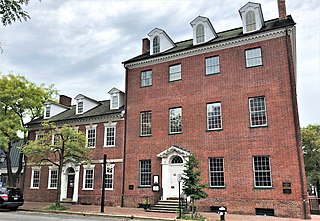
Gadsby's Tavern is a complex of historic buildings at 134 and 138 North Royal Street at the corner of Cameron Street in the Old Town district of Alexandria, Virginia. The complex includes a c.1785 tavern, the 1792 City Tavern and Hotel, and an 1878 hotel addition. The taverns were a central part of the social, economic, political, and educational life of the city of Alexandria at the time. Currently, the complex is home to Gadsby's Tavern Restaurant, American Legion Post 24, and Gadsby's Tavern Museum, a cultural history museum. The museum houses exhibits of early American life in Virginia, and the restaurant operates in the original 1792 City Tavern dining room, serving a mixture of period and modern foods.

Shepherd Hall, also known as Monument Place and formerly as Stone Mansion, is a historic house listed on the National Register of Historic Places in the city of Wheeling in the U.S. state of West Virginia. It is located in the Elm Grove area of Wheeling, Ohio County, West Virginia.

Alexander Robinson Boteler was a nineteenth-century planter turned businessman, as well as artist, writer, lawyer, Confederate officer, philanthropist and politician from Shepherdstown in what was initially Virginia and became West Virginia in the American Civil War.

Falling Spring at Morgan's Grove is part of a related complex of buildings and lands associated with the Morgan family and other prominent members of the Shepherdstown, West Virginia, community.
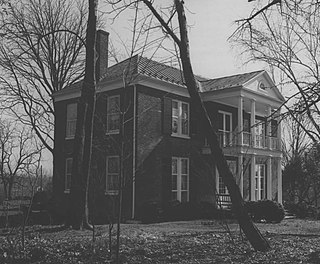
The Morgan-Bedinger-Dandridge House — first known as Poplar Grove, then Rosebrake or Rose Brake — is part of a group of structures affiliated with the Morgan's Grove rural historic district near Shepherdstown, West Virginia. The property was known as "Poplar Grove" until 1877.

Cold Spring is a house near Shepherdstown, West Virginia, childhood home to two United States Representatives. The house was built by Edward Lucas III and his son, Robert in 1793.
Boidstones Place, also called Greenbrakes and Fountain Rock, was built in 1766 by Thomas Boydston near Shepherdstown, West Virginia on land he was granted by Thomas Fairfax, 6th Lord Fairfax of Cameron. In a dispute with Fairfax and Joist Hite over lands he had acquired along the Terrapin Neck on the Potomac River, Boydston lost most of his lands, which were acquired by Abraham Shepherd. The property formed a portion of the Shepherd's holdings along Shepherd Grade, which were primarily devoted breeding race horses. Some of the property was annexed to the adjoining Wild Goose property, owned by R.D. Shepherd, who had a racetrack there. In 1851 R.D. Shepherd gave Boidstones to his nephew and namesake R. D. Shepherd, Jr. who built the main Greek Revival section of the house. The property was sold out of the Shepherd family in 1886, but was returned to the Shepherds in 1916 for use as a summer place.

The Shepherdstown Historic District comprises the historic core of Shepherdstown, West Virginia. The town is the oldest in West Virginia, founded in 1762 as Mecklenburg. No structures are known to exist from the time before the town became known as Shepherdstown. The historic district is concentrated along German Street, the main street, with 386 contributing resources and 69 non-contributing elements. The chief representative period is the late 18th century, with many Federal style brick houses. German Street is also furnished with 19th-century "street furniture" such as metal fences, mounting blocks, wooden pumps and mature trees.

Point of Honor is an historic home, now a city museum, located in Lynchburg, Virginia. The property has commanding views of the city and the James River. Its name originated due to the land on which it is built being used as a clandestine dueling ground.

The Conrad Shindler House is a historic building, now home to the George Tyler Moore Center for the Study of the Civil War, in Shepherdstown, West Virginia.
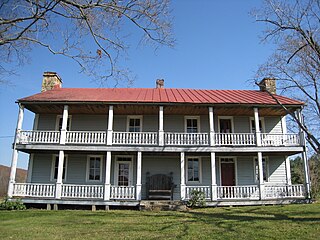
Hook Tavern is a late 18th-century tavern along the Northwestern Turnpike east of Capon Bridge in Hampshire County, West Virginia. It was listed on the National Register of Historic Places on April 29, 2011.

The Walker Tavern is a historic structure located at 11710 U.S. Route 12 in Cambridge Township in northwesternmost Lenawee County, Michigan. It was designated as a Michigan Historic Site on February 19, 1958, and was later the county's first property added to the National Register of Historic Places on January 25, 1971. The structure was incorporated into the Cambridge Junction Historic State Park and continues to serve as a museum and venue for various events.
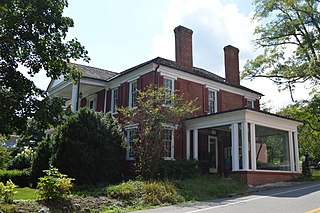
The John A. North House is a historic house museum and archives located in Lewisburg, Greenbrier County, West Virginia. Currently, the North House is Greenbrier County's only historic house museum. Since 1976, The Greenbrier Historical Society has operated within the North House, and in 1992 the North House was officially purchased by the Greenbrier Historical Society. In 1992, the home officially became known as "North House Museum, Greenbrier Historical Society."
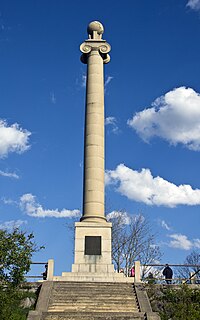
The James Rumsey Monument, also known as Rumsey Monument Park, is a municipal park and former West Virginia state park in Shepherdstown, Jefferson County in the U.S. state of West Virginia. The park overlooks the Potomac River. It commemorates local inventor James Rumsey and his successful public demonstration of his steamboat invention on the Potomac in 1787. The monument consists of a 75 ft (23 m) column of Woodstock granite, which is capped with a globe and stands atop a tall, concrete plinth consisting of a 40 sq ft (3.7 m2) plaza.
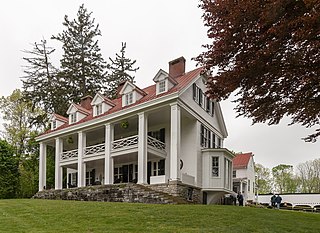
Wild Goose Farm is a 173-acre (70 ha) farm complex near Shepherdstown, West Virginia, established in the early 19th century. The farm includes a large, irregularly-arranged main house, a Pennsylvania-style bank barn, a tenant house, and outbuildings including a spring house, smoke house, ice house, corn crib, water tower and a decorative pavilion.
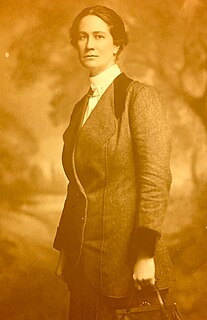
Violet Dandridge, was the pseudonym for Serena Katherine Dandridge (1878–1956), she was an American scientific illustrator, painter, naturalist, and suffragist. She was the Smithsonian Institution’s first female scientific illustrator.





















